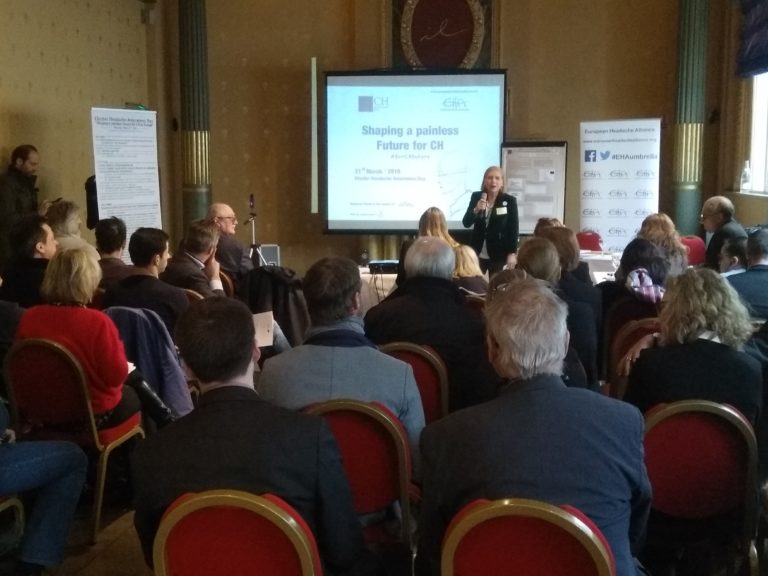On Cluster Headache Awareness Day (CH), Cultures Connection has joined the European Headache Alliance to organize a conference on this rare disease.
On the occasion of Cluster Headache Awareness Day (CH), Cultures Connection has joined the European Headache Alliance to organize a conference on this rare disease during which a dozen of European professors and doctors have spoken.
The European Headache Alliance association met on 21 March 2018 in Paris, to consider the issue of Cluster Headache (CH), a condition characterized by intense, repetitive pain in the face, typically near the eye or temple. Very often, this pain is concentrated on one side of the face unilaterally during attacks that can last from a few minutes to several hours. During the conference, the questions addressed were specific and, initially, dealt with the psychological suffering caused. For many patients, the condition results in the appearance of psychological disorders due to very intense and repetitive pain which can reach up to 6 attacks per day in certain patients, it is therefore uncommon that problems such as suicidal thoughts appear. The suicide rate for people with CH is 20 times higher than average, which is why it is important to treat the psychological side of this disease.
The discussions around this condition pose real problems, at the European level, on the recognition of the disease and the improvement of treatments. To this day, there is no definitive cure for CH. However, there are treatments that provide strong relief to patients in the event of a crisis. Unfortunately, it must be noted that the majority are not available from the AMM, which is the Marketing Authority. Despite the rarity of this condition, it is still necessary to look at the question of treatments but also at the diagnosis of this disease. CH only affects 0.5% of the population, still unknown and difficult to detect, the average delay in diagnosis would be between 10 and 15 years. Therefore, this conference represents a major challenge: raising awareness among the medical profession and the general public about the existence of this condition. For our interpreter Thomas Valere, one of the challenges of this conference would be to bring an international aspect to it: “There needs to be an international organization for this disease which has too few patients per country to compile statistics in order to advance medicine”.
The conference interpreter and their role
On this day’s program, there were about a dozen speeches in English. The association therefore called Cultures Connection for their conference interpretation services where two of our interpreters went to render their services, translating from English to French.
A conference interpreter is a linguistic professional whose role is to simultaneously reproduce a speech in a foreign language. Despite popular opinion, interpreters are specialized in two or three languages in which they have a very thorough knowledge. Indeed, conference interpreting is not an oral translation but the expression of a cultural reality. Therefore, conference interpreters are a key element to communication within a conference since they are the people who make the link between a speaker and the audience, to be able to deliver a message.
At a conference or congress, interpreters lend themselves to simultaneous interpretation: how does it work? The interpreters are located in soundproof booths, each positioned according to their linguistic specialty, where they listen to the speakers’ speech through headphones. While listening to the speech, they must simultaneously translate it into the target language. The translation is then received by the audience who also has a headset and a box allowing them to choose the language.
Conference interpreting is a service which demands a lot of skill, especially during a conference on the theme of CH, when the subject is a medical disorder. In cases like this, conference interpreting requires very in-depth knowledge. For greater fluency, the interpreter must be able, in a very short time, to understand, analyze and reproduce the speaker’s message as faithfully and accurately as possible. Sabrina Carnevalli, conference interpreter, shares her experience on the importance of preparation with us: “It is important to be well prepared for such a mission, to master the technical terms and to be well informed about the client, the speakers if possible, the symptoms of the disease as well as the medical techniques and treatments presented.” In fact, an interpreter will only be able to accurately transcribe what they have understood, so a thorough job is necessary in advance for this work to be successful.
Good understanding between audience and speakers is therefore essential to the progress of the issues raised. Interpreters occupy a fundamental place in the debate. We are happy to have been able to provide our interpretation services in Paris during this conference and to have played a part in concrete progress being made in favor of a better understanding and management of this disease.
Translation into English: Chloe Findlay
Discover our interpretation services.



